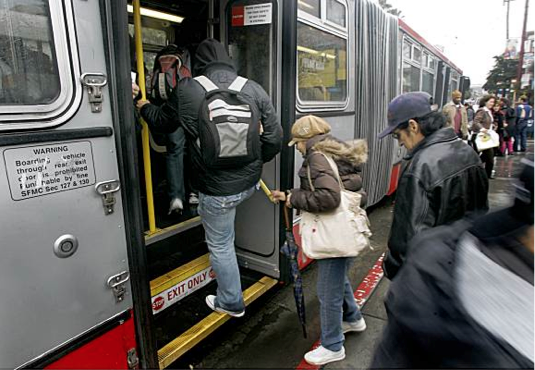Muni Considering All-Door Boarding
All-door boarding is already a reality on most Muni lines, but now it might actually become legal. As first reported by the SF Chronicle, SFMTA is considering all-door boarding on Muni buses. A recent Reset San Francisco survey showed 64% of respondents in favor of MUNI allowing boarding at both doors of MUNI buses in order to speed up service.
All-door boarding means allowing riders to board through any door on buses when paying with their Clipper card or holding a transfer. All-door boarding makes trips quicker and saves Muni money that can be invested in improved service and reliability.
Under current rules, bus riders only are allowed to board through the front door – near the driver. But let’s be honest, Muni riders know that back door boarding is already a de facto practice.
Many Reset members have expressed doubt about all-door boarding because of concerns about fare evasion. But done correctly – and it at least sounds like this time the MTA is doing the job correctly – the plan will make the system faster and more secure from evasion.
Along with the change to allow all-door boarding, the Municipal Railway also needs to install ticket machines along the bus and streetcar routes so tickets are always available for purchase. And the savings gained by making the system faster needs to be partially re-invested in more ticket inspectors, who not only reduce fare evasion but also improve safety through their presence.
SFMTA says high traffic buses such as the 1 California, 38 Geary, 14 Mission and 30-Stockton spend about 20 percent of their operating time boarding at bus stops. San Francisco has some of the slowest transit speeds in the nation, with the average Muni train and bus running at a measly 8mph. Those slow speeds are a hindrance to easy mobility throughout the city and discourage people from taking transit. Increasing Muni bus speed from its current average of 8mph to just 10mph would save the agency $40 million a year.
All-door boarding was just one of a number of recommended measures in the city’s three year-old Transit Effectiveness Project (TEP) aimed at increasing Muni speed.
In order to allow all-door boarding, on lines like the J Church, Muni will install ticket machines on the sidewalk at stops and require customers to have a proof-of-payment once they get on board at any door. Clipper card users can already do as much by tapping their cards at fare readers near the back doors.
Simple changes, like all-door boarding can have big impacts on Muni’s performance and reliability. Most buses are already equipped with Clipper card readers at the back door, and all-door boarding is already a reality on most Muni lines. This was one of the ideas San Franciscans and Muni experts mentioned as immediate simple changes Muni could take to improve service at our Reset Hot Button town hall on Muni reform. All-door boarding is just one way to bring Muni up to its voter-mandated standard of 85% on-time performance.
What do you think? If you agree that all-door boarding will speed up our commutes and make Muni faster and more efficient – sign the petition and we will deliver it to the MTA.








